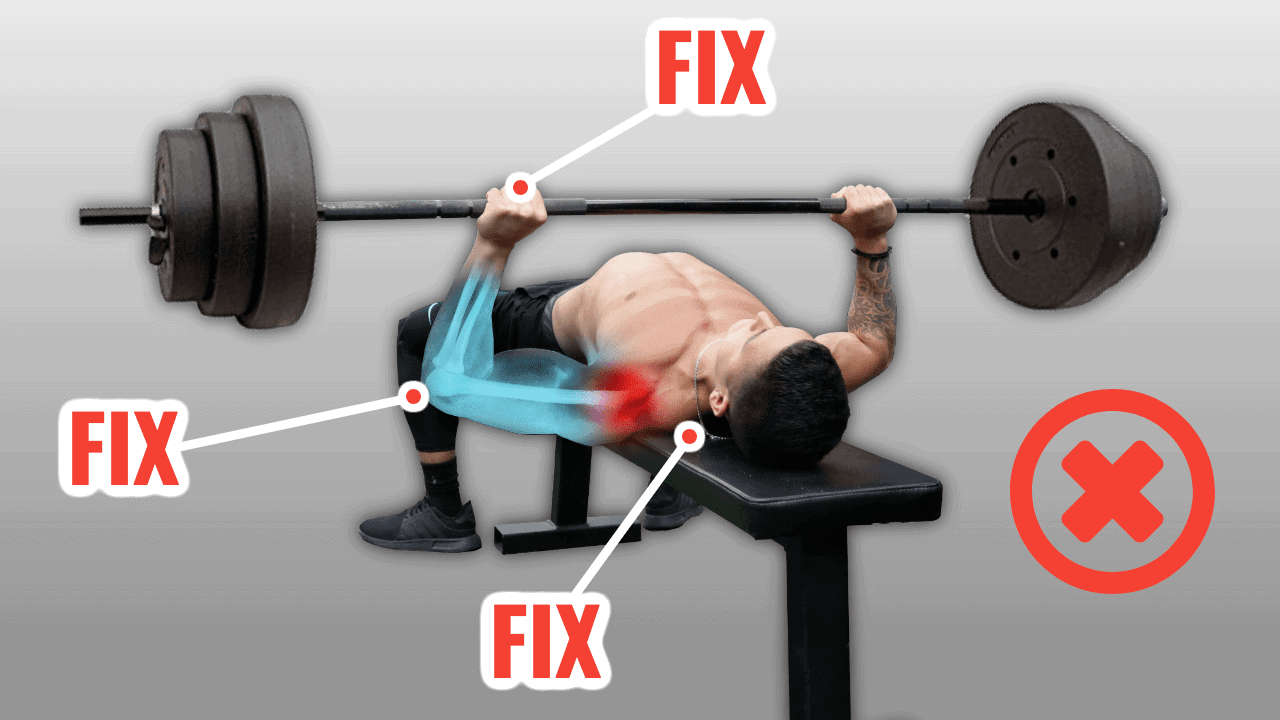If you’re experiencing shoulder pain after bench pressing, you’re not alone. This common issue can greatly hinder your progress and performance in the gym.
However, with the right knowledge and techniques, you can overcome this shoulder pain and continue to make progress on your bench press.
In this article, we will explore the common causes of shoulder pain from bench press techniques and provide you with practical solutions to fix it.

Common Causes of Shoulder Pain from Bench Press Techniques
Poor Technique and Form
One of the most common causes of shoulder pain during bench press is poor technique and form. Many beginners tend to arch their back excessively, leading to excessive pressure on the shoulders. Additionally, flaring out the elbows and not maintaining proper scapular retraction can also contribute to shoulder pain.
To fix this issue, it is crucial to focus on maintaining a neutral grip and wrist alignment. Make sure your wrists are stacked directly above your elbows throughout the entire movement. This will help reduce unnecessary stress on the shoulders.
Overtraining and Lack of Proper Recovery
Overtraining and lack of proper recovery can also contribute to shoulder pain. Pushing yourself too hard, not allowing sufficient rest and recovery time, can lead to overuse injuries and muscular imbalances.
To address this, it is important to listen to your body and give yourself adequate rest days between training sessions. Incorporating mobility and flexibility work into your routine can also help promote better recovery and prevent shoulder pain.
Muscular Imbalances and Weaknesses
Another common cause of shoulder pain from bench press techniques is muscular imbalances and weaknesses. This occurs when certain muscles, such as the anterior deltoids and pectorals, become overly dominant while others, such as the rotator cuffs and scapular stabilizers, remain weak.
To fix this issue, it is important to address these muscular imbalances through targeted shoulder strengthening exercises. This will help to balance your upper body development and ensure that all muscles are working together effectively and efficiently.

Proper Technique and Form for Shoulder-friendly Bench Press
Neutral Grip and Wrist Alignment
To perform the bench press with shoulder-friendly technique and form, it is important to maintain a neutral grip and wrist alignment. This means that your palms should face inward, towards each other, throughout the entire movement. Avoid excessive pronation or supination of the wrists, as this can put unnecessary stress on the shoulders.
Proper Scapular Retraction and Positioning
Another important aspect of proper technique is maintaining proper scapular retraction and positioning. When setting up on the bench, retract your shoulder blades by squeezing them together. This will help stabilize the shoulders and provide a strong base of support during the lift.
Throughout the movement, focus on keeping your shoulder blades pinned back and down. This will help maintain proper shoulder alignment and distribute the load evenly across the shoulders.
Range of Motion and Elbow Position
Proper range of motion and elbow position are also crucial for a shoulder-friendly bench press. Lower the bar until it touches your chest, allowing your elbows to naturally bend and tuck in towards your sides. Avoid flaring out your elbows, as this can increase the strain on your shoulders.
By maintaining proper range of motion and elbow position, you can ensure that the load is directed towards the muscles of the chest and triceps, rather than placing excessive stress on the shoulder joint.
Preventing Shoulder Pain through Warm-up and Preparation
Dynamic Shoulder Warm-up Exercises
Before starting any bench press session, it is important to perform a dynamic shoulder warm-up. This will help increase blood flow to the muscles, enhance joint mobility, and activate the stabilizing muscles around the shoulders.
Some examples of dynamic shoulder warm-up exercises include arm circles, shoulder dislocations with a resistance band, and shoulder rotations. Perform these exercises for about 5-10 minutes to properly warm up your shoulders and prepare them for the bench press.
Activation and Strengthening of Key Muscles
In addition to warming up, it is important to activate and strengthen the key muscles involved in the bench press. These include the rotator cuff muscles and the scapular stabilizers.
Incorporate exercises such as external rotations with resistance bands and scapular retractions into your warm-up or as part of your accessory exercises. This will help activate and strengthen these muscles, reducing the risk of shoulder pain.
Mobility and Flexibility Drills
Improving shoulder mobility and flexibility can also play a significant role in preventing shoulder pain during bench press. It is important to focus on stretching and mobilizing the muscles around the shoulders, including the chest, shoulders, and upper back.
Perform exercises such as pec stretches, shoulder stretches, and upper back foam rolling to improve mobility and flexibility in these areas. This will help ensure proper range of motion during the bench press and can help alleviate shoulder pain.

Addressing Muscular Imbalances and Weaknesses
Specific Shoulder Strengthening Exercises
To address muscular imbalances and weaknesses, it is important to incorporate specific shoulder strengthening exercises into your training routine. These exercises will help strengthen the weak muscles and balance out the overall strength of your upper body.
Some examples of shoulder strengthening exercises include dumbbell shoulder presses, face pulls, and lateral raises. Perform these exercises with proper form and gradually increase the weight as you get stronger.
Targeted Training for Rotator Cuff and Scapular Stabilizers
To specifically target the rotator cuff and scapular stabilizers, incorporate exercises such as external rotations, YTWLs, and prone T’s into your routine. These exercises will help strengthen these muscles, improving their ability to stabilize the shoulder joint during bench press.
Balancing Upper Body Development
Additionally, it is important to focus on balancing your upper body development. This means not neglecting muscles such as the rhomboids, rear deltoids, and upper back muscles. Including exercises such as bent-over rows, face pulls, and pull-ups in your routine will help maintain balanced muscle development and reduce the risk of shoulder pain.
Recovery, Rest, and Injury Prevention
Proper Rest and Recovery Days
To prevent shoulder pain and reduce the risk of overuse injuries, it is essential to prioritize proper rest and recovery. Allow your body enough time to recover between training sessions, especially those involving the bench press.
Aim for at least one to two rest days per week and consider incorporating active recovery activities into your routine, such as light mobility work or low-intensity cardio. This will aid in muscle repair and reduce the risk of overtraining.
Incorporating Mobility and Flexibility Work
In addition to rest, incorporating regular mobility and flexibility work into your routine is crucial for injury prevention. Take 10-15 minutes at the end of your workouts to stretch and foam roll the muscles around your shoulders, chest, and upper back.
This will help improve flexibility, release tension, and enhance overall range of motion in your shoulders. The improved mobility will not only reduce the risk of shoulder pain but also enhance your bench press performance.
Avoiding Overtraining and Common Mistakes
Overtraining and common training mistakes can lead to shoulder pain and hinder your progress. Avoid excessive volume or intensity that your body is not ready to handle. Gradually increase weight and intensity over time to prevent overuse injuries.
It is also important to focus on maintaining proper form and technique throughout your bench press. Poor form can lead to unnecessary stress on the shoulders and increase the risk of injury.

Alternative Exercises and Modifications
Dumbbell Bench Press and Variations
If you continue to experience shoulder pain despite correcting your technique and addressing muscle imbalances, consider incorporating alternative exercises that place less stress on the shoulders.
Dumbbell bench press is a great alternative as it allows for a more natural range of motion and individual arm control. Start with light weights and gradually increase the load as you become more comfortable and pain-free.
Floor Press and Board Press
Floor press and board press are also effective modifications that can help alleviate shoulder pain. These exercises limit the range of motion and decrease the stress on the shoulders, making them shoulder-friendly options.
By reducing the range of motion, you can focus on strengthening the chest and triceps without aggravating your shoulder pain. Incorporate these exercises into your routine and gradually progress as your shoulder pain subsides.
Incline and Decline Bench Press
Lastly, adjusting the bench angle during bench press can also help alleviate shoulder pain. Incline bench press shifts some of the focus onto the upper chest and shoulders, which can be beneficial for those with shoulder pain.
On the other hand, decline bench press shifts the focus onto the lower chest and triceps, putting less stress on the shoulders. Experiment with different angles and find what works best for you and your specific shoulder condition.
Seeking Professional Help and Guidance
Consulting a Qualified Strength and Conditioning Coach
If you continue to experience persistent shoulder pain despite implementing the above techniques, it may be beneficial to consult a qualified strength and conditioning coach. They can assess your technique, identify any muscle imbalances or weaknesses, and provide personalized guidance to help you overcome shoulder pain.
Working with a Physical Therapist or Sports Medicine Specialist
In some cases, working with a physical therapist or sports medicine specialist may be necessary to address more severe shoulder issues. They can provide a comprehensive assessment of your shoulder condition, as well as prescribe specific exercises and stretches to strengthen and rehabilitate the affected muscles.
Getting a Comprehensive Shoulder Assessment
In order to fully understand the root cause of your shoulder pain and receive the most appropriate treatment, consider getting a comprehensive shoulder assessment. This assessment can be done by a qualified physical therapist or sports medicine specialist and will evaluate your shoulder mobility, stability, and overall function.
By understanding the specific factors contributing to your shoulder pain, you can take the necessary steps to address them and prevent further injury.

Importance of Listening to Your Body
Recognizing Warning Signs and Pain
Listening to your body is crucial for maintaining optimal health and preventing injuries. Learn to recognize warning signs and pain associated with your shoulder during bench press.
If you experience sharp or intense pain during or after bench press, it is important to stop immediately and seek professional help. Pushing through the pain can exacerbate the injury and lead to a longer recovery time.
Modifying Exercises and Intensity
When it comes to shoulder pain, it is important to modify exercises and intensity levels based on your individual limitations. This may mean reducing the weight, adjusting the range of motion, or using alternative exercises altogether.
By modifying the exercises to suit your specific needs, you can continue to work towards your goals while minimizing the risk of further shoulder pain or injury.
Understanding Individual Limitations
Finally, understanding your individual limitations is key to preventing shoulder pain. Every person is different, and what works for one individual may not work for another. It is important to understand your body’s limitations and work within them.
Don’t compare yourself to others or feel pressured to lift heavier weights if it compromises your form or causes pain. Focus on your own progress and listen to your body in order to achieve long-term success on the bench press.
Benefits of Proper Shoulder-friendly Bench Press Techniques
Improved Performance and Strength
By implementing proper shoulder-friendly bench press techniques, you can greatly improve your performance and strength. With the right form and technique, you’ll be able to engage the targeted muscles more effectively, leading to greater gains in strength and muscle development.
Reduced Risk of Shoulder Injuries
The risk of shoulder injuries can be significantly reduced by using proper technique and addressing any muscular imbalances or weaknesses. By following the guidelines discussed in this article, you can minimize the stress on your shoulders and prevent common bench press-related injuries.
Enhanced Upper Body Muscle Development
Proper shoulder-friendly bench press techniques will also enhance your upper body muscle development. By ensuring that all muscles are working together harmoniously, you can achieve a balanced and well-developed physique.
Conclusion
Shoulder pain from bench press techniques can be frustrating, but it is not an insurmountable obstacle. By focusing on proper technique, addressing muscular imbalances, and incorporating appropriate modifications and exercises, you can effectively overcome shoulder pain and continue to make progress on your bench press.
Remember to prioritize rest and recovery, seek professional help if needed, and listen to your body. With dedication and proper knowledge, you can enjoy the benefits of a stronger bench press while keeping shoulder pain at bay. Happy lifting!




